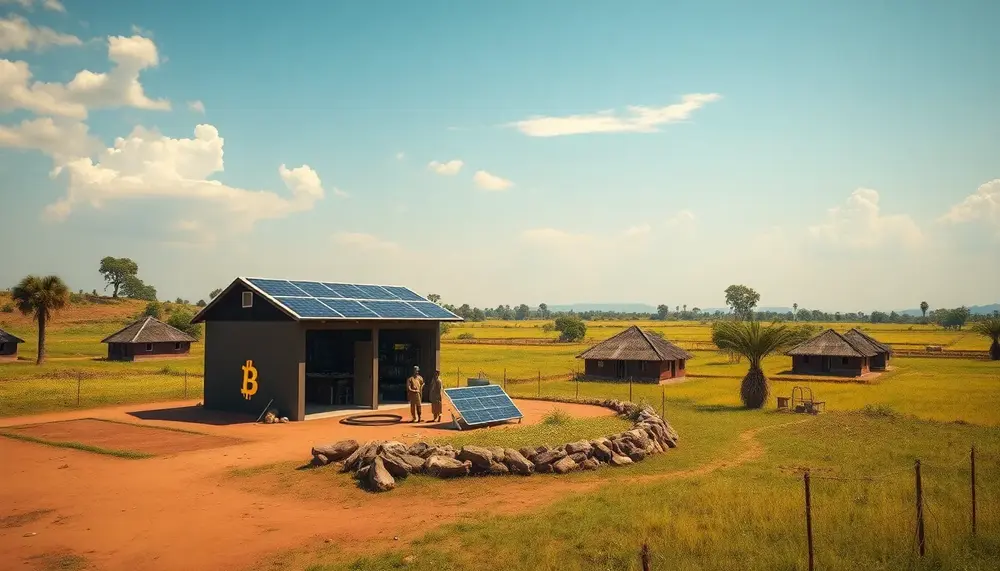Bitcoin-Mining in Sambia: Eine Partnerschaft mit Potenzial
In der nordwestlichen Region Sambias, entlang des Sambesi-Flusses, hat eine innovative Partnerschaft zwischen dem Bitcoin-Mining-Unternehmen Gridless und dem lokalen Zengamina-Wasserkraftwerk das Leben der dortigen Bevölkerung nachhaltig verändert. Diese Zusammenarbeit nutzt überschüssige Energie des Wasserkraftwerks, die zuvor ungenutzt blieb, um Bitcoin zu schürfen. Laut IT BOLTWISE® x Artificial Intelligence hat dies nicht nur die Stromkosten für die lokale Bevölkerung gesenkt, sondern auch die Lebensqualität der 15.000 Einwohner erheblich verbessert.
Vor der Ankunft von Gridless war die Stromversorgung in der Region teuer und unzuverlässig. Das Wasserkraftwerk konnte seine gesamte erzeugte Energie nicht nutzen, was zu Ineffizienzen führte. Durch die Nutzung der überschüssigen Energie für das Bitcoin-Mining deckt Gridless nun 30 % der Betriebskosten des Kraftwerks. Dies hat zu einer stabileren und günstigeren Stromversorgung für die Gemeinde geführt.
| Aspekt | Details |
|---|---|
| Region | Nordwestliches Sambia |
| Einwohner | 15.000 |
| Deckung der Betriebskosten | 30 % durch Bitcoin-Mining |
„Die Partnerschaft zwischen Gridless und dem Zengamina-Wasserkraftwerk ist ein Paradebeispiel für die Nutzung sogenannter 'stranded energy' – Energiequellen, die aufgrund ihrer geografischen Lage oder anderer Faktoren nicht vollständig genutzt werden können.“ – IT BOLTWISE® x Artificial Intelligence
Die Partnerschaft zeigt, wie erneuerbare Energien und innovative Technologien wie Bitcoin-Mining kombiniert werden können, um wirtschaftliche und soziale Vorteile zu schaffen. Allerdings steht die Zukunft dieser Zusammenarbeit auf dem Spiel. Das Zengamina-Wasserkraftwerk hat kürzlich eine Finanzierung erhalten, um sich an das nationale Stromnetz anzuschließen. Dies könnte die wirtschaftliche Grundlage für Gridless gefährden, da die Strompreise im nationalen Netz voraussichtlich höher sein werden als die derzeitigen Kosten für die Nutzung der überschüssigen Wasserkraft.
Experten sehen in dieser Partnerschaft dennoch ein Modell für die Zukunft. Die Kombination aus erneuerbaren Energien und Bitcoin-Mining könnte in anderen Teilen der Welt ähnliche positive Effekte erzielen. Es bleibt abzuwarten, ob Gridless in der Lage sein wird, neue Standorte für seine Mining-Aktivitäten zu finden.
- Die Partnerschaft hat die Stromkosten in der Region gesenkt.
- 30 % der Betriebskosten des Wasserkraftwerks werden durch Bitcoin-Mining gedeckt.
- Die Zukunft der Zusammenarbeit ist aufgrund der geplanten Anbindung an das nationale Stromnetz ungewiss.
Zusammenfassung: Die Partnerschaft zwischen Gridless und dem Zengamina-Wasserkraftwerk in Sambia zeigt, wie überschüssige Energie effizient genutzt werden kann, um sowohl wirtschaftliche als auch soziale Vorteile zu schaffen. Trotz der Erfolge steht die Zukunft des Projekts vor Herausforderungen, die langfristige Lösungen erfordern.
Sources:















